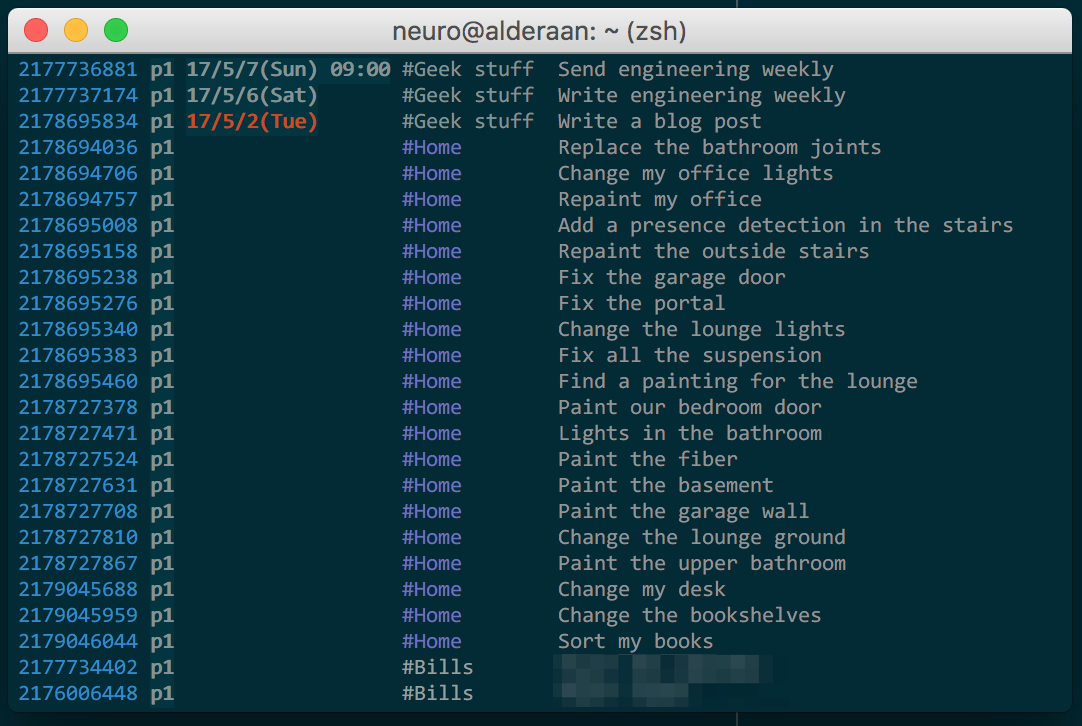Best Cli Tool For Mac
The Azure CLI is a command-line tool providing a great experience for managing Azure resources. The CLI is designedto make scripting easy, query data, support long-running operations, and more. Try it today and find out what the CLI has to offer!
The current version of the Azure CLI is 2.0.72. For information about the latest release, see the release notes. To find your installed version and see if you need to update, run az --version.
Demo of Installing the OCI-CLI on Mac OSX (2018.11.27) OCI-CLI: Oracle Cloud OCI Command Line Interface. Aqua For Command-Line Tools provides point-and-click user interfaces for controlling the command-line tools shipped with Mac OS X. Use it to: Run powerful Unix tools with point-and-click ease.
- Install on Linux or Windows Subsystem for Linux (WSL)
Note
Coherent PDF Command Line Tools 2.2.Patchlevel.1 - For merging, splitting, encrypting, stamping, and bookmarking PDFs. Download the latest versions of the best Mac apps at safe and trusted MacUpdate Download, install, or update Coherent PDF Command Line Tools for Mac from MacUpdate. Aqua For Command-Line Tools provides point-and-click user interfaces for controlling the command-line tools shipped with Mac OS X. Use it to: Run powerful Unix tools with point-and-click ease.
If you're using the Azure classic deployment model, install the Azure classic CLI.
Typing commands into a terminal may seem tedious, but with the right tools, the command line can be incredibly powerful. Here are our favorite command line tools that do awesome things you just can't match in a GUI.
Note: While a lot of the tutorials and videos on this page are Linux-centric, these commands are useful for everyone. Mac users can use all of these commands in their Terminal as well, and Windows users can check out Cygwin for a more UNIX-like terminal experience where these tools come in handy. Also note that not every tool comes preinstalled on every system, so you may need to install some of them separately before you can use them.
Advertisement
Geek to Live: Introduction to Cygwin, Part I
Introduction to who? If that's what you thought when you saw the title of this article, then…
Read more Read10. Top
When your computer starts to freeze, slow down, or just misbehave, the top command can help you set things straight. By just typing top into a terminal, you can get a list of every program running on your system, as well as how much of your system's resources they're taking up. Then, if you find one that's gone a bit haywire, you can kill it and restore your system to its normal, speedy self. The whole thing takes a few seconds and you don't need to wait for any windows or fancy graphs to load. Check out this quick introduction to top for more, and if you want something a bit friendlier, the htop command is a pretty great replacement.
Advertisement
Control Your System with the Top Command
On Linux and Mac systems, the top terminal command gives you a great bird's eye view of what…
 Read more Read
Read more Read9. Ifconfig
If you have more than one computer in your house, chances are you'll need to dig into your network settings from time to time. Knowing your network can help you controlling your HTPC, monitoring your BitTorrent downloads, or sharing files between computers. When that time comes, ifconfig will be your best friend. It shows you the IP address of your computer, the MAC address of your Ethernet and Wi-Fi cards, and a ton more. Check out this introduction to ifconfig to see how it's used.

Advertisement
The Remote Control Conundrum: How to Choose the Right Remote for Your Home Theater PC
Cli Tool Python
So you've got yourself a kickass, play-everything home theater PC, but you're not so keen …
Read more Read8. Chmod and Chown
Every once in awhile, you'll come across a 'permission denied' error when trying to access a file, and it can be infuriating. Running chmod will edit the permissions of any file, letting you read, write, and/or execute a given file according to your specifications. You can do this from the GUI, but chmod is a bit more powerful, especially if you're working with multiple files. To see how it's used, check out this guide to chmod and its brother chown, which helps you get full ownership of a file.
Advertisement
7. SSH
Why set up a full screen sharing system when all you need to do is check up on one simple thing? SSH connects you to another computer and lets you use its terminal as if you were sitting right in front of it. You can check running processes, change permissions, and access files on your remote machine right from the machine in front of you. It can do a lot more too, from controlling a monitor-less home serverto encrypting your web browsing on a less-than-secure connection. Heck, it can even help you manage your jailbroken iOS device.
Advertisement
Use Your Computer From Anywhere: A Guide to Remote Controlling Your PC
Your home computer is the perfect machine. It's customized to your exact needs, runs all your…
Read more Read6. Wget
You can can head to a web site and download a file in one click, but if you want serious control over your downloads wget is the best for the job. With a few keystrokes you can automatically download all the music on a web site, resume downloads that keep flaking out, or even grab the entire archive of NASA's 'Astronomy Picture of the Day'. Check out our guide to mastering wget to see everything this little tool can do.
Azure Cli Mac
Advertisement
Download the Entire Archive of Nasa's Astronomy Picture of the Day with One Command
Nasa's Astronomy Picture of the Day archive is a packed with awe-inspiring, high-resolution…
Read moreBest Terminal Tool For Mac
Read5. Vi and Vim
Despite all the fancy writing tools out there plain text is still one of the most useful ways to manage information. It can make for an extremely versatile to-do list, help you tweak settings for your favorite app, or even let you build an entire web site. And while there are a lot of great text editors out there, a lot of power users swear by Vi and Vim. Vi and Vim are command line text editors that are entirely keyboard-based, letting you navigate large blocks of text with just a few keystrokes. If you're serious about editing text, these editors are the way to go, despite their learning curve. Thankfully, the web is full of tutorials on how to use them.
Advertisement
Why You Should Set Up Your To-Do List in a Plain Text File (and How to Do It)
Your to-do list is the hub of your personal productivity, so it makes sense that we're…
 Read more Read
Read more Read4. Grep
Not all command line work is clean and simple. Sometimes, you'll run a command and get a giant wall of text in return that's impossible to wade through. Luckily, grep will help you find what you're looking for. On its own, it can search through any text within a file on your system for a specific phrase (e.g. grep Laundry todo.txt), which is useful in and of itself. However, grep's real power comes when used in conjunction with other commands. Can't find what you're looking for in the output of top? You can use grep to search for the program you're looking for. Check out this tutorial to learn how to use grep, and to combine it with other commands, you just need to learn...
Advertisement
3. Pipes
Pipes isn't the name of a specific tool, but rather a class of tools that help you send the output of one command to another command. Take our example from #4, where we wanted to find something specific in the output of top. To do this, you would run something like top -l 2 | grep firefox. The | symbol pipes the output of top to grep, which then searches for firefox and finds you the relevant information. You can also pipe the output of a command to a text file with the > symbol, such as: ifconfig > myip.txt. For more examples of how to use pipes, check out our command line primer for beginners.
Advertisement
A Command Line Primer for Beginners
The command line isn't just for wise Linux beards. It's actually an awesome tool with…
Read more Read2. Find
Unlike grep, which searches for text within files, find is a tool that helps you find files based on other criteria—like name, filetype, or when they were last edited. It's much more powerful than the traditional Spotlight search or Windows search, and one of the best way to quickly find files on your system. Plus, if you want to search for something within a file, you can pipe the output of find into grep and figure it out. To see how it's done, check out this great tutorial for the find command.
Advertisement
1. Apt-Get and Other Package Managers
If you're tired of opening up a web browser and visiting a web site just to download a program, package managers are a godsend. Package managers—like Ubuntu's apt-get, Arch Linux's pacman, or OS X's homebrew make installation a snap. With them, you can search a large database of applications, as well as download and install them with just a few keystrokes. All you need to know is the name of the application you're looking for. It'll even install any prerequisites you need for that program—like Java—so you don't have to do that yourself. What package manager you use generally depends on your OS, so Google around to see what managers are available for your system and what apps are available in their repositories.
Best Mac Network Tools
Advertisement
If you've gotten really tired of the GUI, check out our list of unconventional command line apps and if you haven't done it yet, be sure to read up on how to become a command line ninja with time-saving shortcuts.
Advertisement
Put Your System on a Diet: Replace Bloated Apps with Command-Line Alternatives
Modern operating systems have no shortage of feature-rich applications. The problem: Sometimes…
Read more Read